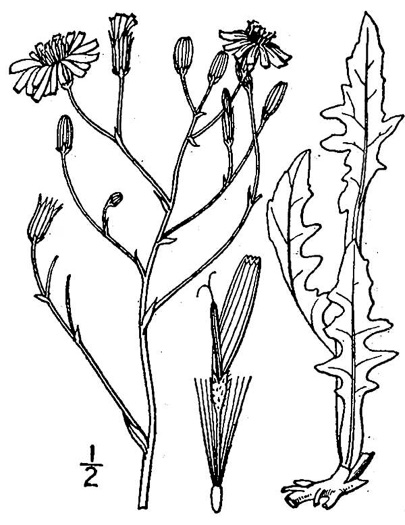Spermatophytes (seed plants): Angiosperms (flowering plants): Eudicots: Core Eudicots: Asterids: Campanulids: Asterales
WEAKLEY'S FLORA OF THE SOUTHEASTERN US (4/24/22):
Crepis pulchra
FAMILY
Asteraceae_
Go to FSUS key
Dig deeper at SERNEC, a consortium of southeastern herbaria.
Smallflower Hawksbeard most resembles C. capillaris, but the stems have stipitate glands (vs. not stipitate in that species). Read more at Vascular Plants of North Carolina.
SYNONYMOUS WITH
PLANTS NATIONAL DATABASE:
Crepis pulchra
FAMILY
Asteraceae_
SYNONYMOUS WITH Floristic Synthesis of North America. BONAP (Kartesz, 2021)
Crepis pulchra
SYNONYMOUS WITH Flora of North America north of Mexico, vol. 19-20-21 (2006)
Crepis pulchra
SYNONYMOUS WITH VASCULAR FLORA OF THE CAROLINAS (Radford, Ahles, & Bell, 1968) 179-11-002:
Crepis pulchra FAMILY Asteraceae_
COMMON NAME:
Smallflower Hawksbeard
To see larger pictures, click or hover over the thumbnails.
WEAKLEY'S FLORA OF THE SOUTHEASTERN US (4/24/22):
Crepis pulchra
FAMILY
Asteraceae_
SYNONYMOUS WITH
PLANTS NATIONAL DATABASE:
Crepis pulchra
FAMILY
Asteraceae_
SYNONYMOUS WITH
Floristic Synthesis of North America. BONAP (Kartesz, 2021)
Crepis pulchra
SYNONYMOUS WITH
Flora of North America north of Mexico, vol. 19-20-21
Crepis pulchra
SYNONYMOUS WITH
VASCULAR FLORA OF THE CAROLINAS (Radford, Ahles, & Bell, 1968) 179-11-002:
Crepis pulchra
FAMILY
Asteraceae_
If a search such as "Carex leptalea var. leptalea" doesn't deliver the results you want, try "Carex leptalea".
Or, to minimize chances of a misspelling, try just "Carex le".
Less is more: If "pencil flower" doesn't deliver the results you want, try "pencil".


